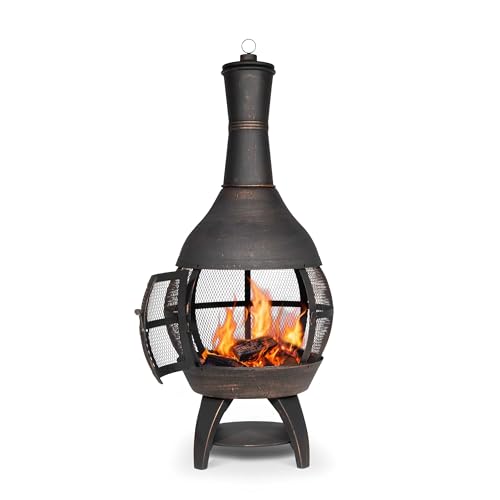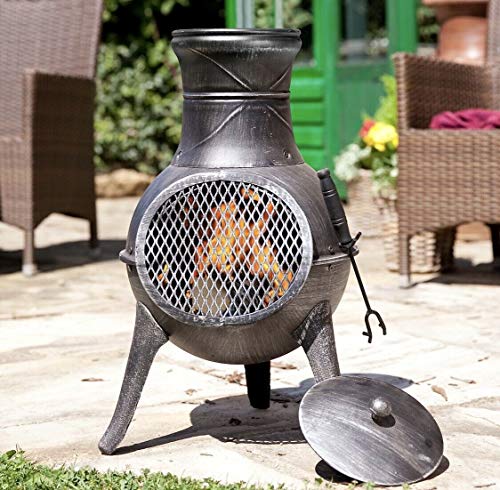What's The Job Market For Ceramic Chiminea Professionals?
페이지 정보

본문
Clay is the most popular material used to make chimineas. Think terra cotta plant pots or the red pottery ones. Clay is strong and hard however, it is susceptible to cracking when handled incorrectly.
The clay in a chiminea is highly absorbent and needs to be protected with gravel or sand at the bottom along with logs, kindling, and other materials. This stops the clay from burning too hot and closes hairline cracks.
Materials
The traditional clay chimineas (also known as pot-bellied ovens) have a chimney which emits smoke upwards. Chimineas of this type have a glaze to protect them from cracking and weathering caused by sudden temperature fluctuations. They are still vulnerable to rain and sunlight. This makes it essential to cover them when not in use, and to ensure that no water puddles develop within the clay.
The majority of chimineas are made from clay terracotta. Other materials like cast iron and steel can be used as well. Terracotta is an authentic Mexican-inspired design while aluminum and cast iron are durable alternatives that require less maintenance than terracotta. Certain manufacturers offer modern designs which combine the beauty and durability of a chiminea made of clay.
Many people match their chimineas sale to flowering or evergreen plants. This creates a natural look that complements the ambience of their backyard. It is essential to select the right plant combinations the chiminea has to be located in a place that is free of structures that can catch fire. It is also important to make sure that the chiminea's location is on a safe surface such as concrete, brick or stone patios.
Chiminesas can be made by hand using high-fired, unglazed clay. The potter is the one who creates the clay. They can make use of the mold of a plaster or wheel of a potter. In either case, clay is kneaded before it is allowed to dry. Some newer clay chimineas are pre-grogged, which is an additive that can help to withstand thermal stresses that are prone to cracking traditional earthenware.
Other chimineas are constructed using molds made of metal which give them diversity of style and shape to suit any backyard. Cast iron chimineas can be heavier than clay models, however they are more durable and less likely to break or crack due to sudden temperature changes. They are less expensive than other kinds of chimineas too and are available in gas-burning models as well to provide additional versatility.
 Styles
StylesA chiminea is a fireplace that can be decorated in various styles and materials. Terracotta chimineas provide the traditional look that has been around for centuries and metal options are more durable and can handle high temperatures. Many chimineas feature designs and patterns that complement the surrounding furniture on the patio. A rustic finish, for example gives your chiminea a vintage look particularly if you pair it with iron or wood patio furniture.
Chimineas can be a freestanding structure or a mounted on a patio that is made of brick, stone or concrete. No matter where you decide to put your chiminea, make sure it is protected from wind and from any plant or structure that is flammable. It is important to remember that chimineas can emit smoke and soot that can influence the air quality in the area.
Certain chimineas have an opening for the chimney at the base of the structure while others are pointed upwards and squat. Both models come with or without an opening that is large enough to accommodate firewood. The chimneys of squat models may also be shaped to increase visual appeal and create a striking design.
You can also add decorative features to the outside of your Chiminea such as wrought iron, marble, or granite. To add a touch of style, you could consider an aluminum or copper top. These finishes reflect light and improve the look of your chiminea metal.
A regular chiminea-polish is a good way to protect your outdoor fire pit from harm and beautify it. Use beeswax, olive oil or other natural products to polish the surface for an elegant, glowing finish. Apply a thin layer and rub gently. Rinse and dry your chiminea in order to achieve a radiant appearance.
Chimineas require a lot of maintenance, but with the right care and attention, your unique outdoor chiminea can look fashionable for a long time. By using efficient decorating strategies and maintaining your chiminea, you will be able to enjoy it well into the cooler seasons.
Safety
Although chimineas are a popular choice but they can be dangers to safety if they are not properly used. Chimineas made from clay are prone to cracking, particularly those that are not glaze-coated. They also pose an ignition risk in proximity to flammable materials such as your furniture, your home and in the garden chiminea. You should only use your chiminea outdoors, and in an area surrounded by a fire-resistant material or fenced.
You should always keep a fire extinguisher close by and use it when needed to put out small flames or hot coals that may occur when you are attempting to tend the flame. You could also use a long lighter for lighting your fire, and move the coals with tongs instead of using your hands. A bucket of water is a good thing to have near by in case the chiminea has to be extinguished. It is important not to use water to extinguish the chiminea's fire after it has cooled. Instead, add water only when the fire has completely stopped or if the chimney is at risk of bursting.
A simple spark arrestor, made of chicken wire, and placed on top of the smokestack will protect your home as well as your neighbors from accidental burns. Chimineas can also be very hot, and the area around them. It is recommended to put up a low wall to warn people against getting too close to.
 Don't burn your chiminea when it's stormy or rainy weather. The sparks could cause a chimney to catch on fire and cause damage to your home. Before using a chiminea, check with the local fire department to confirm that there aren't any burning bans in place. Before adding firewood to your chiminea, make sure you clear the area surrounding it. This will ensure that there aren't any materials that could ignite in the area. You should also clean the inside of your fireplace after every use. This will prevent the accumulation of ash, which can cause smoke inhalation, or a sooty exterior.
Don't burn your chiminea when it's stormy or rainy weather. The sparks could cause a chimney to catch on fire and cause damage to your home. Before using a chiminea, check with the local fire department to confirm that there aren't any burning bans in place. Before adding firewood to your chiminea, make sure you clear the area surrounding it. This will ensure that there aren't any materials that could ignite in the area. You should also clean the inside of your fireplace after every use. This will prevent the accumulation of ash, which can cause smoke inhalation, or a sooty exterior.Maintenance
Despite the fact that they can be used for outdoor fires, clay chimineas are not maintenance-free devices. To ensure their durability they must be handled the same as all clay products. This means avoiding allowing them to become too hot too quickly, and making sure to allow them to cool down between each use. They should also be regularly sanded and sealed to keep the paint from getting damaged.
The first step to keep your chiminea in good shape is to clean the ashes off it after every use, but only after the thing has completely cooled down. It will still be warm, even though it appears to be cooling, so make use of an ice breaker and a brush to remove the ash. After you have carefully swept away the ash and cleared away the debris the next step will be to fill the inside of the chiminea's bottom with either gravel or sand. If you do not fill it your chiminea might crack. The clay absorbs moisture and can crack when it becomes too dried.
Some sources recommend sealing the outside of the chiminea using an acrylic waterproofing agent, similar to those used to seal tiles. This will prevent moisture from damaging the chiminea. In times of frequent use, it is recommended that you remove the chiminea and sand it every 6-8 weeks.
Chimineas are only to be used on surfaces that are free of wood or other coverings. Using only well-seasoned hardwood will also reduce the amount of sparks produced and help to avoid cracking the clay.
Since a chiminea is constructed of clay it will not last forever, but it is extremely difficult to break one unless you beat it with the hammer or drop it. Cracks can develop for a variety of reasons, such as poor burning or a lack of maintenance. They also are susceptible to rust and require to be kept covered, at the very least, when not in use. This will keep rain and snow off of it, ensuring that it does not start to corrode the metal parts of the chiminea.
- 이전글What's The Job Market For Chiminea Fireplaces Professionals? 24.10.22
- 다음글Patio Door Repair Near Me Tools To Ease Your Daily Life Patio Door Repair Near Me Trick That Everyone Should Learn 24.10.22
댓글목록
등록된 댓글이 없습니다.
 KR
KR
